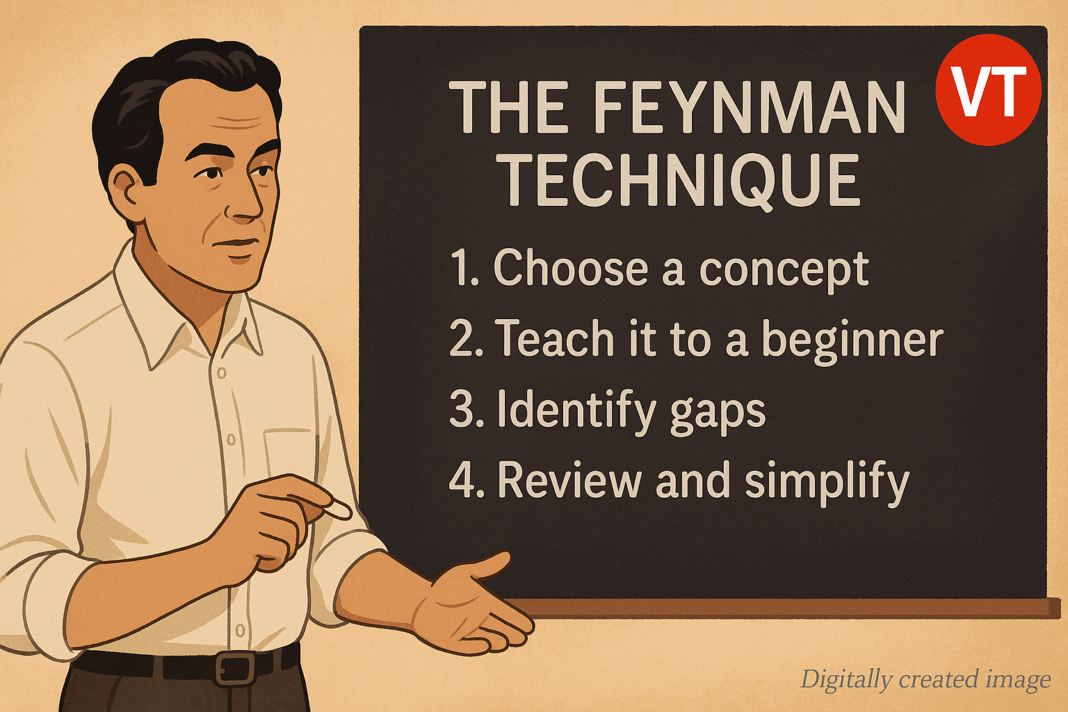Discover a proven method to explain and retain difficult ideas by simplifying them into teachable knowledge.
- The Feynman Technique is a 4-step method developed by physicist Richard Feynman.
- It helps learners simplify and clearly explain complex topics to reinforce understanding.
- Used widely in education, science, business, and communication training.
- Originated from Feynman’s lectures at Caltech, later compiled in The Feynman Lectures on Physics.
- Proven to boost retention, confidence, and clarity in both writing and speaking.
When it comes to learning something new—especially a difficult or abstract concept—many of us turn to notes, textbooks, or endless videos. But what if the real secret to mastering complexity lies not in what you consume, but in how you explain it?
That’s where the Feynman Technique comes in—a deceptively simple but profoundly powerful learning method named after Nobel Prize-winning physicist Richard Feynman. Feynman was famous for his ability to explain the most intricate scientific theories in plain, accessible language. His secret? If you can’t explain something simply, you don’t understand it well enough.
The Historical Roots of the Feynman Technique
The origins of the Feynman Technique trace back to the 1960s, when Feynman taught undergraduate physics at the California Institute of Technology (Caltech). During his lectures, Feynman emphasized the importance of conceptual clarity over memorization. His notes and presentations were later compiled into a classic learning series titled The Feynman Lectures on Physics.

Feynman’s ability to simplify emerged from his own study habits. He would take a topic he didn’t fully understand and challenge himself to explain it in plain English without skipping any steps. If he struggled, he’d go back, revisit the basics, and refine his explanation. This process became the foundation of the Feynman Technique.
Who Was Richard Feynman?
Richard P. Feynman was born in New York City on May 11, 1918. He earned his B.Sc. at MIT in 1939 and his Ph.D. at Princeton University in 1942. He held academic roles at Princeton, Cornell University (1945–1950), and the California Institute of Technology (1950–1988), where he served as the Richard Chace Tolman Professor of Theoretical Physics.
Feynman was a member of the American Physical Society, the National Academy of Sciences, and was elected a foreign member of the Royal Society in London in 1965. He received several major honors including the Albert Einstein Award (1954), the Lawrence Award (1962), and the Nobel Prize in Physics (1965). Feynman passed away on February 15, 1988.
Key Principles of the Feynman Technique
At its core, the Feynman Technique is built on four simple but transformative principles:
- Choose a concept you want to learn.
- Explain it in your own words—as if teaching a child or beginner.
- Identify gaps in your explanation and study to fill them.
- Simplify and refine until your explanation is crystal clear.
This approach not only deepens your understanding, but also builds the ability to communicate effectively—whether you’re writing, teaching, or presenting.
Why It Works So Well
Unlike rote memorization, the Feynman Technique forces you to engage actively with the material. It mimics how great teachers work: by translating knowledge into clear, teachable chunks.
Key benefits include:
- Improved comprehension
- Long-term retention
- Enhanced communication skills
- Greater confidence in your knowledge
Explaining Alzheimer’s Using the Feynman Technique
Let’s apply the technique to explain Alzheimer’s disease to someone without a medical background:

Using simple language makes even serious diseases easier to understand, remember, and discuss—with compassion and accuracy.
Common Uses of the Feynman Technique
This technique has proven useful in a wide variety of fields:
- Education: Students use it to study science, math, medicine, law, and more.
- Writing: Journalists and authors simplify complex ideas for general audiences.
- Business: Entrepreneurs and managers use it to explain strategies to teams and investors.
- Training: Coaches and mentors use it to assess and sharpen understanding in learners.
How You Can Use It Today
Whether you’re a student, a journalist, a manager, or a lifelong learner, the Feynman Technique can be applied anywhere:
- Preparing for presentations or interviews
- Writing clear articles or reports
- Studying for exams
- Explaining tough topics to kids, clients, or the public
All you need is curiosity, a notebook, and the courage to say, “I don’t understand this—yet.”
Final Thoughts
In a world flooded with information, clarity is a superpower. The Feynman Technique gives us the tools to cut through complexity and build true understanding—by doing the simplest, hardest thing of all: teaching it clearly.
Have a topic you’ve struggled to understand? Try using the Feynman Technique today and see how your thinking sharpens. Sometimes, the best way to learn isn’t to know more—it’s to explain better.
If you regularly experience confusion with technical subjects, try writing them down in plain language. Simplifying might be the missing link to mastering it.
*This article is for educational purposes only and does not constitute professional advice. Please consult a qualified educator or expert for guidance.*
A global media for the latest news, entertainment, music fashion, and more.















